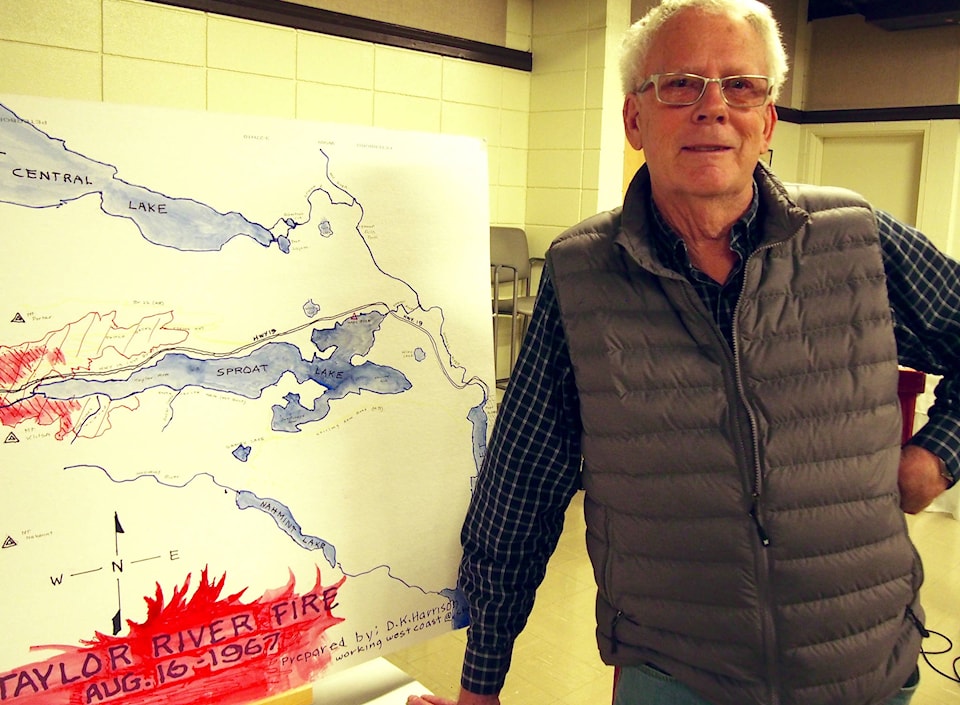BY MIKE YOUDS
Special to the News
There’s no doubt in Doug Harrison’s mind that giant flying tankers such as the Martin Mars could once again play a role in controlling coastal wildfires.
Harrison — who grew up at Great Central Lake in the 1950s and watched as the famed firefighting aircraft took flight — returned to Port Alberni last month as a guest of the Alberni Valley Heritage Society.
The retired engineer and firefighter, now a painter and amateur historian residing on Gabriola Island, gave a firsthand, seat-of-the-pants account of the Mars and some of the major blazes they fought in the area.
“Whether it will fly again?” he asked rhetorically of the awe-inspiring aircraft, a unique workhorse with a history closely linked to the Valley. “I have no idea.”
Though not an expert on the subject, Harrison was in his domain as took his Echo Centre audience back to the summer of 1958, one of the worst in B.C. wildfire history. He was a teen, working alongside pilots, loggers and other firefighters marshalled against a big blaze at Great Central Lake.
“It looked like there was an atomic bomb up at the end of the lake. I looked at that and thought, ‘Holy smoke.’ ”
Three aircraft were used on that fire, including a Grumman Goose piloted by Dan McIvor. Harrison singled out McIvor (1911-2005), a recognized aviation pioneer who flew the Mars in the ’60s and ’70s, as one who helped get the idea off the ground. He remembered some of the men tossing around ideas in casual conversation.
“I feel this was some of the original brainstorming for the Mars.”
Fires were mostly fought with ground crews in those days yet rallying resources to effectively contain larger remote blazes takes precious time. The 1967 Taylor River Fire, sparked by power-pole blasting in Sutton Pass, exploded to 10,000 acres in 24 hours, Harrison said.
“We fought that fire for 19 days. We had every logger on Vancouver Island on that fire. It was like the Battle of the Bulge. It was a helluva mess.”
Logging companies had a firefighting philosophy different from that of the B.C. Forest Service, Harrison said. The flying boat repeatedly came up as the best means of delivering the most water or retardant in the least time. Four that sat idle down in the U.S. were purchased by a consortium of logging companies using Sproat Lake as a base. After some hesitation, they agreed to purchase the fleet for $100,000, a small fortune in 1960.
“It was a fantastic deal.”
At the time, the Mars epitomized the philosophy embraced by those in the forest industry when it came to wildfire: Hit it hard and hit it fast.
“A few times it’s really bailed us out,” Harrison said. “The idea was to get there fast. The idea was to get the thing in the air and get on that fire immediately.”
He spent his career working in the forest industry and saw occasional service on “bird dog” duty in smaller aircraft used to guide the Mars to optimal effect in steep, mountainous terrain. Pilots with the skills and experience necessary to handle the aircraft, often ex-military, represented a small and elite club. They sometimes paid for that privilege with their lives.
Though designed for military use, the Mars had its origins in the evolution of civil aeronautics in the decade leading up to the Second World War. Flying boats were adapted as the first commercial passenger aircraft — mostly transporting the rich and famous around the globe — in the years before airports were developed.
With its 200-foot wingspan capable of delivering a 6,000-gallon payload, the Mars is distinguished as the largest operational flying boat. The more famous Spruce Goose famously flew just once “only because Howard Hughes had to get in the air to get paid by the U.S. military,” Harrison said.
Public speculation over the Mars returning to service seems to flare up at regular intervals, especially in challenging fire seasons. Harrison steered clear of conjecture but offered an homage to the Mars — the Hawaii Mars is still drydocked at Sproat Lake as part of the Coulson Flying Tankers fleet — and the wisdom of its design. With major, so-called interface wildfires seemingly on the rise in recent seasons, giant flying boats may be as important in the future as they were in the past, he suggested.
“The point I would like to make is, I think we should be looking more at aircraft that can pick up water.”
